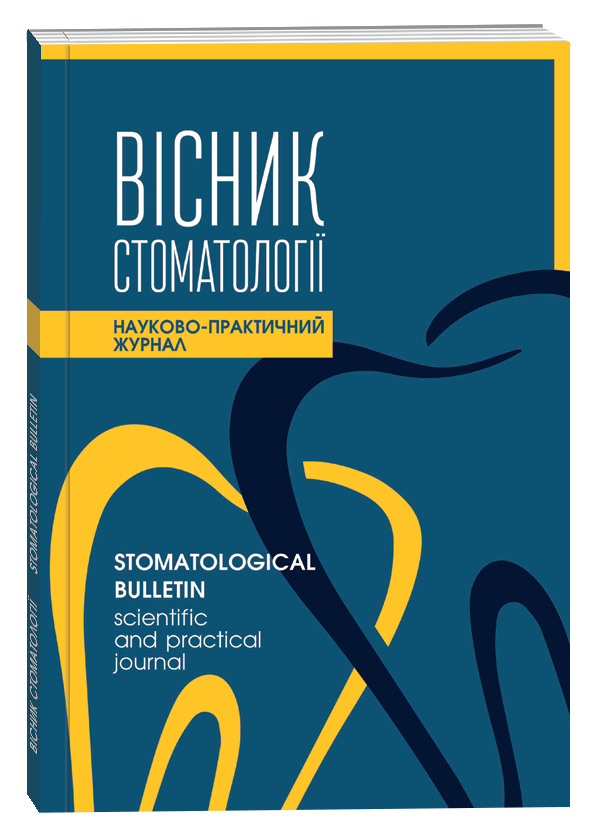CLINICAL EVALUATION OF EFFECTIVENESS OF INFLUENCE EXPERIENCE OF HIGH-OLEIC SUNFLOWER OIL ON THE STOMATOLOGICAL STATUS OF CHILDREN
DOI:
https://doi.org/10.35220/2078-8916-2019-32-2-57-61Keywords:
prevention, nutrition, main dental diseasesAbstract
The purpose of the study. To increase the effectiveness of pre-vention of major dental diseases in children due to the use of high-oleic sunflower oil "Olive".
Materials and methods. The study involved 76 children aged 14-15, studying in a military lyceum, eating and living in an ed-ucational institution.
The survey was conducted in a dental office, using a dental mir-ror and a probe, as well as a periodontal probe to assess the state of periodontal tissues. Data were recorded in the dental card of the baby's cavity. The condition of solid teeth tissues (KPUz) and the structure of their lesions (caries, seal, removed teeth), condition of periodontal tissues (PMA %, bleeding, Schil-ler-Pisarev test) and oral hygiene (Silness-Loe, Stallard, dental stone).
The children were divided into 3 groups. The first group includ-ed 26 children, whose diet included the usual sunflower oil "Shchedry Dar". The second group consisted of 24 children, who were assigned a treatment and prophylactic complex, which provided for the use of the following drugs: "Supradin" internal-ly in 1 tablet 1 time per day for a month; "Lizomukoid" for 1 tsp. elixir ¼ cup water, rinse for 1 min. after each meal in a month, and the treatment of teeth with the drug "Gluftored". The course was repeated three times a year. The third group includ-ed 26 children who were assigned a similar TPC, but instead of the usual oil, the olive sunflower oil "Olive" was introduced into the diet.
Research results and their discussion. After the introduction of high oleic sunflower oil into the diet, caries growth by the CPUz index in 2 years in the second group was 0.79, which is almost 1.5 times less than in the control group, in the third group, this figure was 0.62, which is 1,8 times less than in the control group. In this case, the caries prophylactic efficacy of the treat-ment and prophylactic complex in the second group was 31.3 %, however, with the addition to the Olive oil diet, this indicator in the third group in relation to the control group was 46.1 %. This indicates an increase in caries-prophylactic effect when using high-oleic sunflower oil.
In the year of observation, the PMA index % in the control group increased by 14.21 % compared with the initial values, and in the second group, one year later, it was 1.9 times lower than the baseline, while in the group number 3, the index was reduced PMA % 2.6 times compared with the original values.
The bleeding index of the control group in one year remained at the same level, while this figure of group number 2 decreased by 3.4 times in a year, in turn, in the third group the index of bleed-ing decreased in a year by 5.6 times.
The Schiller-Pisarev index in Group 1 increased by 4.31 % year-on-year, in group № 2 there was a decrease in this indica-tor by 1.25 times in the year, while in children of group 3 the year was observed to decrease this index by 1,5 times.
Indicators of oral hygiene in children indicate that in the con-trol group for 6 months the indices Silness-Loe and Stallard de-creased by 17.71 % and 8.91 %, respectively, and one year later – by 22.83 % and 6.8 %. In the second group we see the follow-ing picture: the decline in the Silness-Loe and Stallard indexes for the first half of the year by 12.75 % and 11.83 %, and one year later – by 15.69 % and 16.13 % respectively. At the same time, in the 3rd group, the decline in the index data for half a year occurred on 20 % and 33.8 %, respectively, in a year - by 36.36 % and 37.68 %, respectively. The index of tartar in all groups in the dynamics almost did not change.
Conclusions. 1. The obtained results indicate that high oleic sunflower oil has caries prophylactic and parodontioprotective effect.
2. It is advisable to recommend high-oleic sunflower oil "Olive" as a substitute for ordinary sunflower oil in daily nutrition in order to increase the effectiveness of the prevention of major dental diseases.
References
Левицкий А. П. Идеальная формула жирового питания / А.П. Левицкий. – Одесса: КП «Одеська міська друкарня». - 2002. – 62 c.
Карпенко П. О. Нутриціологія в Україні: розвиток чи передчасна деградація? / П. О. Карпенко, Р. І. Романишин // Журнал практикующего врача. – 1998. – № 3. – С. 18-19.
Переверзева Э.В. Питание современного человека: путь развития или деградации? / Э.В. Переверзева, С.Н. Филиппова // Вестник РМАТ. – 2015. - № 4. - С. 117-131;
Кулакова С. Н. Возможности использования раститель-ных масел тропического происхождения / С. Н. Кулакова, В. В. Бессонов // Пищевая промышленность. – 2013. – № 4. – С. 14 – 17.
Guidelines: Saturated fatty acid and trans-fatty acid intake for adults and children. Geneva: World Health Organization; 2018 (Draft is-sued for public consultation in May 2018.
Ехнева Т. Л. Динамика заболеваемости и смертности на-селения Украины старше трудоспособного возраста за 10-летний период (1996-2005 г.) / Т. Л. Ехнева, В. Н.Веселова, В. М. Норин-ская // Проблемы старения и долголетия. – 2006. – т. 15, № 3. – С. 247-262.
Левицький А. П. Роль високоолеїнової соняшникової олії у вирішенні проблеми жирового забезпечення сільськогоспо-дарських тварин та птиці / А. П. Левицький, А. П. Лапінська, І. В. Ходаков // Зернові продукти і комбікорма. – 2016. – T. 62, №2. – C.38-43.
Титов В. Н. Роль пальмитиновой жирной кислоты в инициации гипертриглицеридемии, гиперхолестеринемии, атеро-склероза и атероматоза / В. Н. Титов, Т. А. Рожкова, В. А. Аме-люшкина // Международный медицинский журнал. – 2015. – Т. 21, № 2(82). – С. 5-14.
Шнайдер С. А. Состояние тканей полости рта крыс по-сле кормления высокоолеиновым подсолнечным маслом / С. А. Шнайдер, И. Г. Топов, А. П. Левицкий // Вісник стоматології. – 2016. – № 3. – С. 6-10.








